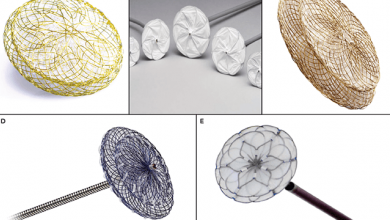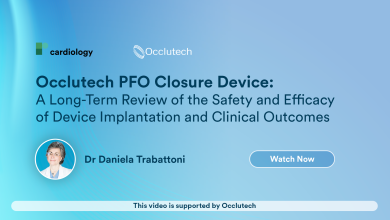Search results
Frontiers of Patent Foramen Ovale Closure and New Design Improvements - A Review of the Literature
Author(s):
Raquel del Valle-Fernández
,
Carlos E Ruiz
Added:
3 years ago
Article
Author(s):
Amit Bhan
,
Brian Clapp
Added:
3 years ago
The foramen ovale is an integral component of the fetal circulation, responsible for facilitating the flow of placental pre-xygenated venous blood from the right atrium to the left, thereby circumventing the quiescent developing lungs. Physiological closure is usually achieved after birth when pulmonary vascular resistance and right heart pressures reduce, resulting in the left atrial pressure…
View more
Author(s):
Joel P Giblett
,
Omar Abdul-Samad
,
Leonard M Shapiro
,
et al
Added:
3 years ago
Patent foramen ovale (PFO) is a common abnormality, occurring in 20–34% of the population.1 In the majority of infants, closure of the foramen ovale occurs soon after birth, as negative intrathoracic pressure associated with the first breaths closes the PFO. In some cases, the primum and secundum atrial septa fail to fuse and closure remains incomplete. There is continuing communication between…
View more
Author(s):
Joel P Giblett
,
Lynne K Williams
,
Stephen Kyranis
,
et al
Added:
3 years ago
Patent foramen ovale (PFO) is common and occurs in 20–34% of the population.1 In most infants, the foramen ovale closes soon after birth, with a reduction in pulmonary vascular resistance raising the left atrial pressure above that of the right atrium during the first few breaths, closing the septum. In a significant proportion of individuals, the primum and secundum atrial septa do not fuse, and…
View more
Author(s):
Jennifer Franke
,
Nina Wunderlich
,
Horst Sievert
Added:
3 years ago
As an intra-cardiac right-to-left shunt, the patent foramen ovale (PFO) has gained attention over the last two decades because of its potential pathological importance in a number of disease processes including stroke, peripheral embolism, systemic oxygen desaturation (i.e. hypoxaemia) and migraine headaches. Percutaneous PFO closure, using a double-umbrella Clamshell device (Bard, USCI,…
View more
Author(s):
Daniela Trabattoni
Added:
5 months ago
A single centre, prospective, non-randomised study from DrDaniela Trabattoni (Monzino Cardiology Centre,Milan, IT) following device implantation of the Occlutech PFO Closure device in 442 consecutive patients.The study is particularly interesting due to the scarcity of data available on the long term follow up (over 5 years after) of device implantation. Also, the results are focussed not only…
View more
Author(s):
Joelle Kefer
Added:
3 years ago
Atrial septal abnormalities are common congenital lesions remaining asymptomatic until adulthood in a great number of patients. The most frequent atrial septal defects in adults are ostium secundum atrial septal defect (ASD) and patent foramen ovale (PFO), both approachable by transcatheter closure using device implantation. The first non-surgical ASD closure was performed in 1975 by Mills and…
View more
Author(s):
James Slater
,
Mark Fisch
Added:
3 years ago
The morphology and function of the inter-atrial septum changes dramatically from the period of in utero development until its role in normal adult cardiac physiology is established. Its anatomical construction is complex and involves the eventual formation of a septum secundum, fossa ovalis and septum primum. In utero a mixture of deoxygenated blood from the foetus and oxygenated blood from the…
View more
Author(s):
Brian G Hynes
,
Thomas J Kiernan
,
Nicholas J Ruggiero
,
et al
Added:
3 years ago
Stroke-related morbidity and mortality remain unacceptably high. Recent estimates suggest that it accounts for approximately one out of every 17 deaths in the US, and that a person dies from the direct consequences of stroke every three to four minutes.1 Of the almost 800,000 strokes that occur annually, 87% are ischaemic, the remainder occurring predominantly as a consequence of intracerebral…
View more











